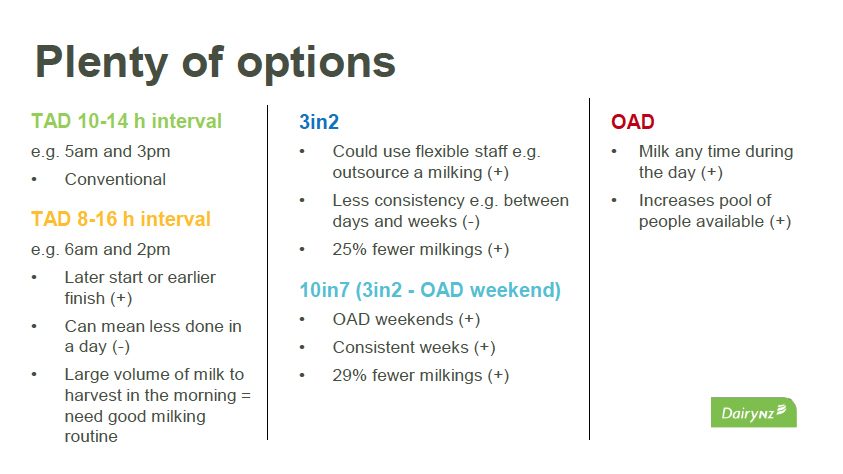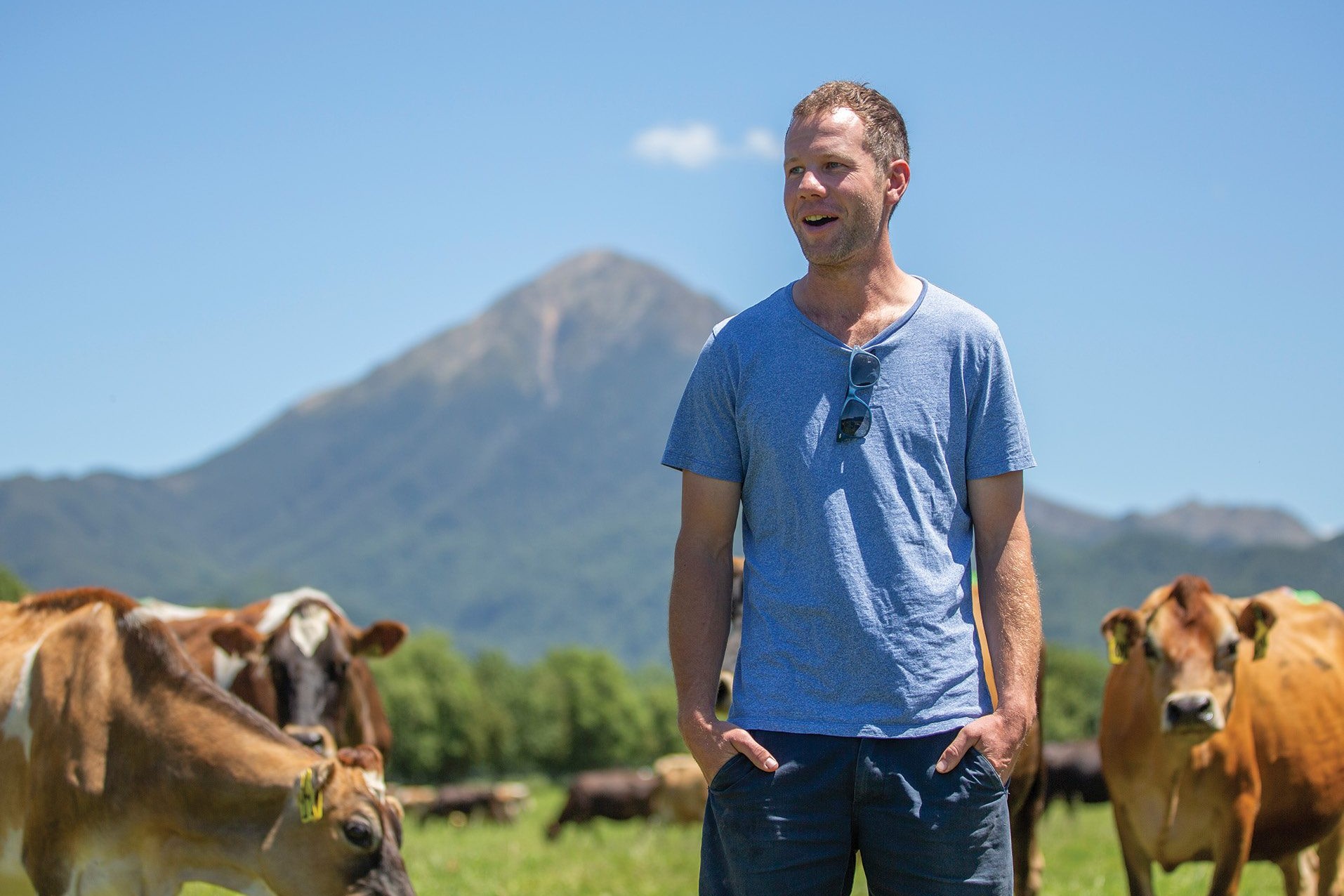By Elaine Fisher
Changing traditional times of milking not only creates more flexibility for farmers and staff but may also serve to attract newcomers to the industry, says Paul Edwards, DairyNZ senior farm systems scientist.
“Can we adapt milking times to create a workplace that will attract people, particularly the next generation of young people who may want to work on farms?” was among the questions Edwards put to the 50 farmers who attended the SMASH (Smaller Milk and Supply Herds), field day near Te Aroha in November.
Long hours of work, especially around the busy times of mating and calving, combined with traditional twice-a-day (TAD) milking were often seen as a negative for employees or career seekers wanting more flexibility and work-life balance.
However, dairy farmers used to the TAD model were often reluctant to consider changing, fearing it may lead to a drop in production or increased risk of mastitis.
Edwards said a recent survey showed that 45% of the national herd was TAD, meaning it was no longer the norm. “Last year 14% of herds were on 3in2, milking three times in two days for part of the lactation; 31% were on OAD for part of the lactation, and 8% of herds were on full season once-a-day milking (OAD).”
Within the national herd on TAD, 14% switched to OAD from Christmas and a further 14% went OAD in late lactation. Then 3in2 was used for 6% of herds from Christmas and for another 5% from late lactation.
This demonstrated that flexible milking strategies were not uncommon, and worth considering for many farms Edwards said.

Full season OAD offered the ultimate in flexibility and was well suited to the 20 to 25% of farms that produce under 300kg MS/cow. It could also suit some of the 20% of the industry in the 301-350kg/MS cow range.
OAD would be harder to justify for higher producing herds and farms with less ability to reduce costs because of, for example, the expense of irrigation or interest.
However, 3in2 could potentially play a beneficial role in New Zealand farm systems. To find out if it could, DairyNZ is, through the Sustainable Farming Fund, into the second year of a three-year project called Flexible Milking.
The first year included a farmlet experiment where one herd milked 3in2 for the whole season (milking times 5am, 5pm, 11am = 12-18-18-hour intervals); one herd milked TAD until December 1 when it switched to 3in2); another herd made the switch from March 1, and the fourth herd was milked TAD for the whole season (6am, 4pm = 10-14-hour intervals). The stocking rate for the farmlets on the Lincoln University Research Dairy farm was 3.5 cows/ha and 29% of the herd were heifers.
Each farmlet was managed independently, but using the same management decision rules, every endeavour was made to ensure management skill was consistent, with the only difference between the herds being the milking times.
The results showed that for a herd producing 444kg MS/cow on TAD, there was likely to be a 0.085kg MS/cow/day decrease for each day in 3in2; and a 5% decrease in MS for the full season 3in2 herd.
Fat content was less affected than protein, decreasing by 3% compared with 8% for protein. Edwards pointed out that this was based on a one-year study, with no carry-over effects.
The change in milking times had an impact on body conditions scores (BCS) as at May 8 in the study year.
The TAD was 4.37 and there was an increase of 0.001 for every day of 3in2 – so for the full season at 3in2 herd BCS was 4.62 – 0.25 more.
However, Edwards said milking at 12- 18-18-hour intervals could still make for long days, which led researchers to ask the question – “is it the number of milkings, or the timing of the milkings that affects production?”
To find out, a six-week experiment was carried out from September 11 to October 22 this year at the 355ha Ashley Dene farm located approximately 15 km west of the Lincoln University campus.
It involved five herds of 40 cows each, with an average of 34 days in milk (DIM) at the start. One herd was milked TAD at 6.30am and 4.30pm; the second was milked 3in2 at 5am, 5pm and 11am (12- 18-18 hour intervals).
The third herd came into the dairy at 5.30am, 3.30pm and 10.30am (10-19-19 hour intervals), the fourth at 6am, 2pm and 10am, (8-20-20 hour intervals), and the fifth herd was milked once a day at 7am.
The experiment showed there was a biologically small but statistically insignificant decrease in milksolids yield between the three 3in2 milking times. The OAD herd milk solids were 1.82 compared with 1.96 for TAD.
The research shows there were plenty of options other than traditional OAD milking for farmers to consider, and the small cost involved in using a 3in2 system makes it worthy of consideration, Edwards said.

Even the traditional TAD interval of 10 to 14 hours between milkings could be changed to 8 and 16 hours – eg 6am and 2pm, giving a later start to the day and an earlier finish.
This did mean a larger volume of milk to be harvested in the morning, which required a good milking routine. Some farmers had expressed concern that, with a later start and earlier finish, less work might be done on farm in a day. That could be an issue, but thoughtful planning and allocation of tasks would overcome that.
The 3in2 model could open the opportunity to employ rural residents, including parents whose school runs normally exclude them from milking roles Edwards said. However, there was less consistency between milking days and weeks and 25% fewer milkings.
Another option which has some appeal was 10in7 which is a variation of 3in2 with only one milking each weekend day, which results in 29% fewer milkings than TAD.
The OAD option was open to milking at any time of the day that suits the farm and staff and also increased the potential pool of people available for permanent or casual employment.
In response to a question about grazing management, Edwards said consideration needed to be given to how much feed was required for herds, especially during the longer intervals between milkings, and the use of automatic gate openers to shift cows and adding tape gates to make larger paddocks were options.
Edwards said he believed adapting flexible milking intervals could improve workplace attractiveness and there were many options available.
“The Lincoln Farmlet results look encouraging for a full season and show more attractive 3in2 milking times are possible. However, if you are considering changing milking times, understand the ‘why’ of that decision and plan carefully in advance.”
One of the farmers attending the field day asked; “Why milk cows in the afternoon when the differences (in milk production) are so small?”
Edwards replied he was a convert to OAD. “But making that change may be a leap of faith for some farmers. Going 3in2 gives farmers the chance to dip their toe in the water. Every farm is different and it won’t suit all, but I challenge people to consider the other options to TAD milking.”
- There is a range of resources on the DairyNZ website – dairynz.co.nz/milking-intervals.





